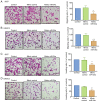MicroRNA‑34a‑5p serves as a tumor suppressor by regulating the cell motility of bladder cancer cells through matrix metalloproteinase‑2 silencing
- PMID: 33650650
- PMCID: PMC7859909
- DOI: 10.3892/or.2020.7910
MicroRNA‑34a‑5p serves as a tumor suppressor by regulating the cell motility of bladder cancer cells through matrix metalloproteinase‑2 silencing
Abstract
Bladder cancer (BC), a common urologic cancer, is the fifth most frequently diagnosed tumor worldwide. hsa‑miR‑34a displays antitumor activity in several types of cancer. However, the functional mechanisms underlying hsa‑miR‑34a in BC remains largely unknown. We observed that hsa‑mir‑34a levels were significantly and negatively associated with clinical disease stage as well as regional lymph node metastasis in human BC. In a series of in vitro investigations, overexpression of hsa‑miR‑34a inhibited cell migration and invasion in BC cell lines 5637 and UMUC3 as detected by Transwell assays. We further found that hsa‑miR‑34a inhibited cell migration and invasion by silencing matrix metalloproteinase‑2 (MMP‑2) expression and thus interrupting MMP‑2‑mediated cell motility. Our analysis of BC datasets from The Cancer Genome Atlas database revealed a negative correlation between hsa‑miR‑34a and MMP‑2. Moreover, higher MMP‑2 protein expression was observed in the BC tissues when compared with that noted in the normal tissue. MMP‑2 levels were also significantly associated with clinical disease stage and poor survival rate in human BC. These findings indicate that MMP‑2 plays a critical role in regulating BC progression. Therefore, hsa‑miR‑34a is a promising treatment to target MMP‑2 for the prevention and inhibition of cell migration and invasion in BC.
Keywords: bladder cancer; microRNA-34a-5p; migration; invasion; MMP-2.
Conflict of interest statement
The authors of this article declare that they do not have any competing interests.
Figures






Similar articles
-
Downregulation of miR-106b induced breast cancer cell invasion and motility in association with overexpression of matrix metalloproteinase 2.Cancer Sci. 2014 Jan;105(1):18-25. doi: 10.1111/cas.12309. Epub 2013 Dec 4. Cancer Sci. 2014. PMID: 24164962 Free PMC article.
-
Tumor-suppressor microRNA-139-5p restrains bladder cancer cell line ECV-304 properties via targeting Connexin 43.Chin Med J (Engl). 2019 Oct 5;132(19):2354-2361. doi: 10.1097/CM9.0000000000000455. Chin Med J (Engl). 2019. PMID: 31567382 Free PMC article.
-
LncRNA MAFG-AS1 regulates miR-125b-5p/SphK1 axis to promote the proliferation, migration, and invasion of bladder cancer cells.Hum Cell. 2021 Mar;34(2):588-597. doi: 10.1007/s13577-020-00470-3. Epub 2021 Jan 5. Hum Cell. 2021. PMID: 33400245 Free PMC article.
-
LINC00312 inhibits the migration and invasion of bladder cancer cells by targeting miR-197-3p.Tumour Biol. 2016 Nov;37(11):14553-14563. doi: 10.1007/s13277-016-5303-8. Epub 2016 Sep 8. Tumour Biol. 2016. PMID: 27631965
-
Ras Suppressor-1 (RSU1) in Cancer Cell Metastasis: A Tale of a Tumor Suppressor.Int J Mol Sci. 2020 Jun 7;21(11):4076. doi: 10.3390/ijms21114076. Int J Mol Sci. 2020. PMID: 32517326 Free PMC article. Review.
Cited by
-
Restoring microRNA-34a overcomes acquired drug resistance and disease progression in human breast cancer cell lines via suppressing the ABCC1 gene.Breast Cancer Res Treat. 2024 Feb;204(1):133-149. doi: 10.1007/s10549-023-07170-0. Epub 2023 Dec 7. Breast Cancer Res Treat. 2024. PMID: 38057687 Free PMC article.
-
Analysis of miRNAs in Osteogenesis imperfecta Caused by Mutations in COL1A1 and COL1A2: Insights into Molecular Mechanisms and Potential Therapeutic Targets.Pharmaceuticals (Basel). 2023 Oct 4;16(10):1414. doi: 10.3390/ph16101414. Pharmaceuticals (Basel). 2023. PMID: 37895885 Free PMC article.
-
Tumor suppressive functions of hsa‑miR‑34a on cell cycle, migration and protective autophagy in bladder cancer.Int J Oncol. 2023 May;62(5):66. doi: 10.3892/ijo.2023.5514. Epub 2023 Apr 21. Int J Oncol. 2023. PMID: 37083075 Free PMC article.
-
Combined miRNA and SERS urine liquid biopsy for the point-of-care diagnosis and molecular stratification of bladder cancer.Mol Med. 2022 Apr 1;28(1):39. doi: 10.1186/s10020-022-00462-z. Mol Med. 2022. PMID: 35365098 Free PMC article.
-
MicroRNA-34 Family in Cancers: Role, Mechanism, and Therapeutic Potential.Cancers (Basel). 2023 Sep 26;15(19):4723. doi: 10.3390/cancers15194723. Cancers (Basel). 2023. PMID: 37835417 Free PMC article. Review.
References
-
- Sylvester RJ, van der Meijden AP, Oosterlinck W, Witjes JA, Bouffioux C, Denis L, Newling DW, Kurth K. Predicting recurrence and progression in individual patients with stage Ta T1 bladder cancer using EORTC risk tables: A combined analysis of 2,596 patients from seven EORTC trials. Eur Urol. 2006;49:466–465. doi: 10.1016/j.eururo.2005.12.031. Discussion 475-467. - DOI - PubMed
MeSH terms
Substances
LinkOut - more resources
Full Text Sources
Medical
Miscellaneous

